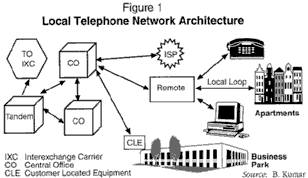
Soaring Internet usage is bringing the U.S. public telephone system perilously close to gridlock by tying up millions of local phone lines every day beginning in the evening and continuing through the night. Although Internet growth has opened up a whole world of opportunities across the industry, the traffic generated is a serious threat to the local exchange service providers who own the last mile of the access network to the customer(s).
This article addresses the impacts and the implications of Internet traffic on the local exchange public network. First, some background on the local exchange telephone network and the assumptions used in the design of telephone networks is provided. Second, the characteristics of voice and Internet traffic are defined. Finally, how Internet traffic impacts the local network is defined. Having identified this impact, some potential solutions for short-term and long-term options will be discussed.
In recent years, there has been explosive growth in Internet-related telephone traffic -- specifically, calls from residential subscribers across the public switched telephone network (PSTN) to Internet service providers (ISPs). Although there are alternative methods for accessing the Internet emerging, the most publicly-accessible connection currently available is via modem calls across the public telephone network. Internet traffic has significantly increased the load on carrier networks, while providing very little compensating revenue. While traffic volume poses an immediate threat to the capacity of the public telephone network at a fundamental level, the characteristics of Internet traffic challenge the engineering, forecasting, planning, and operational procedures established by the former Bell system over the past 80 years.
Simply put, Internet traffic is the exchange, retrieval, and/or communication of information between computers around the world. For information to be transmitted from one point to another, there must be a transmission medium such as fiber, twisted copper pair, coax, or wireless. Currently, twisted copper pair provides the primary interface between the customer's premises equipment and the local telephone company. It gives Internet service providers and users cheap, ubiquitous access with two-way capability -- plus, it's easy to use.
The public telephone network converts the digital information produced by computers into an analog signal that is transmittable over twisted copper pair. The quality of the signal is maintained by converting the analog signal back into a digital format at the first interface point of the network: the central office (CO). The information travels between central offices over fiber optic networks in digital format. The terminating central office performs the reverse process -- converting the digital signal back into analog for transmission from the CO to the customer. The circuit, along with connecting multiple switches, remains intact for the duration of the call. These resources, including switch ports and transmission links used during the call, are not released until the call is completed.
Figure 1 illustrates a typical local telephone network. The network architecture consists of a local loop connected directly or via a remote to a central office. This loop from the customer location to the CO is typically 18 kilofeet or less in length. Twisted copper pair dominates the local loop but, in some cases, fiber is being used. In recent years, the segment from the CO to the remote has been upgraded to fiber for economic reasons.

Today, there are about 25,000 central offices in the United States. Since connecting these COs directly is not a feasible task, network designers introduced a second level of switching called tandem switching or access tandem switching. There are about 1,200 access tandem switches currently in the United States, which aggregate the traffic and route it to the appropriate destination. They typically carry high-volume trunk side (switch to switch) traffic plus a few line side (customer premises to CO) traffic. In other words, very few customers are connected directly to the tandem switches. Long distance carriers usually have their point of presence (POP) co-located with the tandem location. The local service provider hands over to the long distance carrier(s) at the tandem location.
Based on data collected over a period of 80 years, the local telephone network was designed for voice traffic. As a result, other signal types carried over the public telephone network are forced to emulate voice traffic. This means that any traffic that does not require a real-time connection -- fax, e-mail, modem and Internet connections, or computers -- uses the network resources in the same way as voice traffic. Since data traffic does not have the same real-time criteria as voice traffic, network resources are not utilized as efficiently.
In most cases, Internet service providers are connected directly to a high-usage, large central office. However, some Internet traffic traverses through other COs and/or a tandem switch before reaching the terminating CO. In this case, the connection across switches remains intact for the duration of the call.
Based on a detailed understanding of the characteristics of voice traffic, the public telephone network carries voice telephony very efficiently. The assumptions used for voice traffic are as follows:
These assumptions are built into today's operations support systems (OSSs) in conjunction with demand forecasting models.2 These systems monitor trunk usage (capacity) in the network, and utilize the information to decide when and where additional trunking capacity must be deployed. This, in turn, drives network economics such as return on capital investment and determines how efficiently traffic is carried across shared switching and transmission resources. Appropriate traffic models quantify the efficiencies in terms of grade of service. These models for voice telephony are widely used in standards documents, engineering procedures, OSSs, and cost models for the local exchange network.
Based on recent data analysis, the qualitative characteristics of Internet traffic are as follows:3
The Internet call duration varies widely from a few seconds to many hours. In contrast, the probability that a traditional voice call will last longer than 10 minutes is very low, and the probability that it will exceed one hour is virtually zero.
Internet traffic is also quantitatively different from traditional voice traffic. Public telephone network traffic is typically measured in units of Centum Call Seconds (CCS). Table 1 compares residential voice and Internet traffic using CCS as a standard unit of measurement.
| Table 1: Residential Voice & Internet Traffic Comparisons | |
|---|---|
| For residential voice traffic: An average number of calls per hour per subscriber line An average call holding time Average usages on the line | 2 calls per hour 3 minutes 2 x (3 x 60)/100 - 3.6 CSS* |
| For residential internet traffic: An average number of calls per hour per subscriber line An average call holding time Average usage on the line | 2 calls per hour 20 minutes 2 x (20 x 60)/100 - 24 CSS* |
| * Where the maximum possible usage per line is 36 CSS | |
| Source: B. Kumar | |
Historically, residential and business subscriber lines generate about three to six CCS, with the residential lines falling at the lower end of this scale and business lines at the higher end. These assumptions dictate the design of the local network. If the same subscriber line carries both voice and Internet traffic, the average load generated per line can increase substantially. The above example illustrates that usage increases from 3.6 CCS to 24 CCS with the presence of Internet traffic. When the CCS increase occurs, the network must handle more than its "engineered" load. On average, today's Internet traffic generates around 27 CCS. In extreme cases, however, an Internet user may keep a line open for several days, generating the maximum 36 CCS load for many hours.
In summary, the local public telephone network is designed for short calls averaging three minutes in duration. Since Internet calls occupy a line for an average of 20 minutes, the fundamental assumptions used in the design of the public network become invalid.
The Internet draws attention to issues that researchers and scientists have been pondering about the network design: Is it capable of carrying broadband information, namely high-bandwidth integrated voice, data, and video? Although the Internet only deals with data traffic, its implications have created chaos for local telephone service providers. One can imagine the problems an integrated broadband network could cause when no planning or design is done beforehand.
Internet traffic mostly impacts the local exchange network, however, and not the long distance network. This is because most of the customer traffic originates and terminates with an Internet service provider located within the same local exchange network.
The rise in Internet traffic provides an important indication that the center of mass in telecommunications is shifting toward data applications and services. Although the network carries Internet calls in circuit-switched mode, these calls are essentially data calls. The traffic generated in packet data format by PCs can, in principle, be carried far more efficiently and cost-effectively over data networks. Even though suitable data networks exist today, due to cost and equipment limitations, access to these networks is available only to high-volume business users.
| Table 2: Growth of Internet Summary | |||
|---|---|---|---|
| Month | # of Web Sites * | % Commercial * (.com) Sites | Hosts per Web Server |
| 6/93 12/93 6/94 12/94 6/95 1/96 6/96 | 130 623 2,738 10,022 23,500 100,000 230,000 | 1.5 4.6 13.5 18.3 31.3 50.0 N/A | 13,000 3.475 1,095 451 270 94 41 |
| * In thousands. | |||
| Source: B. Kumar | |||
Table 2 illustrates the last three years of growth in U.S. Internet traffic: the statistics on the number of Web sites, the percentage of commercial sites, and the number of hosts/Web servers.
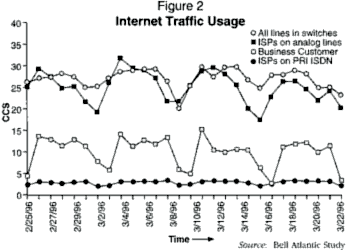
Based on Figure 2, if Internet traffic continues its growth, it will most certainly have an impact on the public network. Table 2 indicates that growth is coming from commercial sites where more and more businesses are using the Internet to share information and conduct business. The public network has also enabled residential users to access the Internet to perform basic research, banking, and, of course, surfing to find out what is out there.
By some estimates, Internet traffic is doubling in size every 45 days. As of December 1996, about 16 million households had access to the World Wide Web. It is forecast that about 60 million households will have access by the year 2000. Adult Americans now spend as much time surfing the WWW as they do watching videotapes. The following statistics obtained from the Internet indicate the growth from various perspectives:
The growth and nature of Internet traffic creates a number of issues for telephone network engineers and planners, the most obvious of which is much higher traffic generated by Internet users. When a significant number of subscriber lines suddenly far exceeds the network engineered load, one can expect significant congestion to occur in several parts of the public network, as shown in Figure 3. The potential Internet congestion points are:
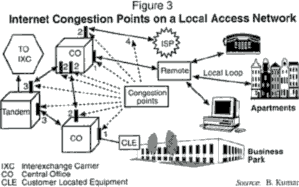
Since Internet traffic is typically funneled into the terminating switch in the metro serving area where the ISP is connected, acute congestion is most likely to occur first at the ISP's terminating switch. Line capacity between the terminating switch and the Internet provider can generate as much as 30 CCS -- or more. Under these conditions, only a fraction of calls are completed; the rest are blocked as a result of line unavailability.
To accurately estimate the additional cost to carriers for supporting Internet traffic over the public telephone network, it is natural to turn to traditional traffic models. However, the characteristics of Internet traffic imply that the traditional models are no longer valid. For example, it is not sufficient to just plug the new elevated subscriber line loads into traditional traffic models and recalculate line concentration ratios because the traditional models tend to underestimate the Internet impact. Hence, new models are required to handle much greater variability such as Internet call holding times and other parameters.
Going beyond the fundamental traffic models and capital costs, the increased variability of Internet traffic will impact the operation of carrier networks in a variety of ways including:
Network service providers have already encountered serious difficulties in areas where Internet traffic levels are significantly high, such as in California. It is important to step back from traditional thinking and evaluate the issues from a long-term perspective.
The implications of high Internet traffic, however, extend beyond the internal planning and operation of the network. Increased traffic directly affects the percentage of completed calls -- regular voice and 911. Blocking probability for traditional voice traffic network is 0.05%. With the addition of Internet traffic this number has has grown to 4%. Though the actual numbers are small, the percentage of change is very significant. The most impacted local network is in California, where 40% of the Internet traffic originates. This Internet traffic has impacted the core of the local service provider. In this era of increased local network competition, the rise of Internet traffic has opened the door for competitors to gain market share. Because they don't have to work with an existing infrastructure, they are in a better position to plan their networks efficiently for the Internet and other new multimedia services.
Slowing the growth of the Internet via tariffs is not a solution. At present, the most common Internet access arrangement is for ISPs to connect to the local terminating switch via large multi-line hunt groups, consisting of hundreds or even thousands of lines. Multi-line hunt groups are typical business lines where calls coming into the customer site are routed to the available line. Typically, a PBX (private branch exchange) or modem banks are connected. Networks take no special actions to identify and route Internet access traffic separately. Voice and data alike use the same switches, trunk groups, and other network resources.
Internet solutions can be categorized into short term and long term. The short-term solution is usually switch-based. Here, the traffic is routed to reduce the blocking at various locations in the network. The long-term solution blocks all traffic at the first interface point to the public network, then routes the traffic to the appropriate switching platform, network, or carrier.
SHORT-TERM SOLUTIONS
LONG-TERM SOLUTIONS
TRUNKING SOLUTIONS
Trunking solutions address the problem of congestion in the trunking network and terminating switch. They are technically feasible but may not be within the full control of local exchange service providers. An ISP buys only as many lines as it deems necessary to the terminating switch. Internet traffic is growing so fast that customer retention is not an issue (at least not in the near term), and customer expectations are different for Internet calls. Consequently, with too few lines to accommodate the offered load, congestion is likely to be a chronic problem on ISP lines.
Trunking solutions generally attempt to reduce stress on the public telephone network by de-loading the switches as far as possible, and by trunking Internet traffic more intelligently. Trunking solutions, however, do not address the central problem of Internet traffic, which is routing the Internet traffic over a data network.
AIN ROUTING/NUMBERING SOLUTION
In this solution, the telephone service provider assigns a dialed number (DN) to a pre-advertised Internet or on-line service provider's telephone number. Based on the defined trigger from the routing table, the originating switch recognizes that the call is for an ISP. The switch then either routes this call to a tandem or a large switching system that has sufficient capacity to carry the data calls (e.g., an underutilized inner-city switch) or routes the call out of the public network onto a packet network.
A potential advantage of the AIN/numbering solution is that it concentrates Internet traffic in relatively few places (e.g., designated trunk groups) and thereby achieves economic efficiencies in the engineering of CO equipment, as well as minimizing capital expenditure for high-performance interfaces between selected tandems and ISPs. On the other hand, it is difficult to update the tables that identify the calls as Internet or as an on-line service provider. Also, this solution becomes invalid in the future if the same call carries voice and video along with data.
SWITCH-BASED ISDN
Data transmission uses only a fraction of the 64 Kb/s circuit-switched bandwidth which is held for the duration of Internet calls. Specifically, this means that data packets are transmitted back and forth across the circuit in rapid bursts followed by relatively long idle periods. Thus, the bandwidth remains unused for most of the call time. However, ISDN calls do not reserve any fixed amount of bandwidth; bandwidth is used only as required.
The packet features of ISDN constitute a different paradigm for communications. Their purpose is to carry packet data traffic, yet they are still not fully deployed. Although there are issues concerning the capacity, engineering, and cost of peripherals, ISDN, in principle, constitutes the most attractive solution for identifying and segregating data calls on the access side of the switch. However, the capacity-related issue does not disappear. But in recent years, router-based ISDN seems to be more attractive.
Router-based ISDN is different from traditional ISDN implementation because it is not part of the traditional switch. Typically, to provide ISDN, one needs to deploy millions of dollars worth of switches. In the case of router-based IDSN, the interface is like any other line card which plugs into traditional routes, and the cost is in the thousands of dollars. Thus, the router-based solution is a cost-effective alternative, especially when the revenues generated from Internet traffic are considered.
PRE-SWITCH ADJUNCT
Pre-switch adjunct is similar to the router-based ISDN alternative. The idea of a pre-switch adjunct is to put some equipment in the switching location (wirecenter) between the subscriber and the local access switch. This adjunct equipment could be a modem or ISDN that would perform table lookup on each call's origination to determine whether it is a data or voice call. If the call is a data call, the adjunct equipment would route the call to a data network via the modem or ISDN function, thus totally bypassing the carrier switch. Call setup and billing would proceed normally, and voice calls would be handled as normal. The disadvantage of this arrangement is establishing network management for additional equipment and the additional costs associated with managing the equipment.
xDSL
xDSL is an emerging technology that would supplement the existing POTS or ISDN line between the subscriber and the local access switch. Figure 4 illustrates the xDSL architecture. It provides more bandwidth from the switch to the subscriber than from the subscriber to the switch. This arrangement is based on the expectation that subscribers will typically want to receive more information (e.g., video images) than they send. xDSL also provides the capability to siphon off data calls on the access side of the switch before they enter the public telephone network to a packet network for efficient transport.
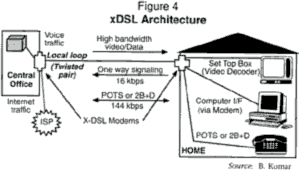
CABLE MODEMS
Cable modems utilize a hybrid fiber/coax (HFC) medium and a media access control (MAC) scheme to share bandwidth among a subset of customers from a cable headend. The technology has the potential to provide high-speed data access to cable-equipped subscribers. Compared with ISDN and xDSL, cable modems represent a solution in which Internet traffic would bypass public telephone networks onto data networks via the CATV network. Figure 5 illustrates this scenario.
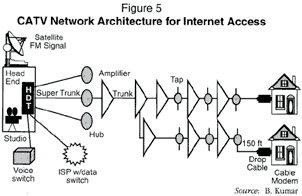
The implementation details of carrying data over CATV are still being explored. Since cable modem technology is implemented in a shared bus architecture that allows for collisions and retransmissions, the effectiveness of the architecture depends on the media access control scheme, traffic characteristics, deployment topologies, and quality of the transmission network among others. These characteristics of the CATV will affect real-world throughput in realistic deployment scenarios. Even though this solution has potential long-term viability, one cannot be sure until all the technical and business hurdles are cleared.
Internet traffic has been a boon for competitors hoping to provide local interconnection services. While local service providers are struggling to decide whether to adopt short-term or long-term solutions and analyzing the cost/benefit tradeoff, competitors have an advantage. With the Telecom Act of 1996, the opening of the local exchange networks, and unencumbered by existing infrastructure, competitors can leap-frog short-term solutions and move directly to long-term solutions. With its focus on creating a competitive environment, the Telecom Act has forced service providers to concentrate their efforts on the service aspect, not on the facilities. For competitors, the act mandates the LECs to provide unbundled network facilities at cost, plus marginal profit to its competitors. As a result, competitors have the opportunity to adopt some of the long-term solutions quickly and easily.
Internet traffic is essentially data traffic that is carried most effectively over data networks. While short-term solutions for supporting Internet traffic could utilize a number of approaches, long-term solutions based on packet technology are the best solution. The solution, however, depends on the business objectives set by the service providers and their service offerings in the long run. Regardless of the solution selected by a carrier, there is a substantial amount of work required to:
At present, a number of incumbent carriers are analyzing the Internet phenomenon and debating the best path to take. Meanwhile, new entrants are moving forward with long-term solutions not only for addressing the Internet traffic, but also for future multimedia traffic. Since the public telephone network currently represents the only near-universal access medium, any long-term solution necessarily involves a staged migration from the present mode of operation toward some packet network solution. The Telecom Act of 1996 opened up the local network, enabling competition to divert some of the Internet and local voice traffic. In fact, competitors can do a more efficient job of not only addressing growing Internet traffic needs, but also other new service(s) on the horizon. They do not have the burden of an existing legacy network architecture and support systems.
Internet statistics were obtained from the following Web sites:
http://www.nlm.nih.gov/publications/staff_publication/rodgers/internet_course/growth.htm.
http://www.muzik.com/info/demographics.htm.
http://www.cs.itu.edu.tr/stat.htm (Internet statistics home page).
http://www.metadiag.co.uk
http://www.weyrich.com/web_business/www-statistics.htm.
http://www.tabnet.com/charts.htm.
http://karlberg/usak.ca/~slgnetstat/netstats.htm.